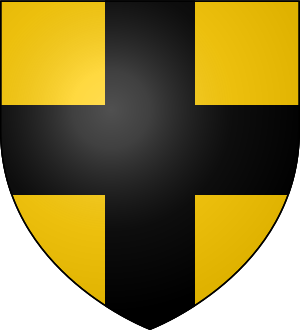John de Vesci facts for kids
Quick facts for kids
John de Vesci
|
|
|---|---|

Coat of arms of John de Vesci
|
|
| Buried | Alnwick Abbey |
| Noble family | de Vesci |
| Spouse(s) | 1. Agnes de Saluzzo 2. Isabella de Beaumont |
| Father | William de Vesci |
| Mother | Agnes de Ferrers |
John de Vesci, sometimes spelled Vescy, was an important noble in the 1200s. He was the oldest son of William de Vesci and Agnes de Ferrers. He married twice. His first wife was Agnes de Saluzzo. His second wife was Isabella de Beaumont. John de Vesci died around the year 1289.
Contents
John de Vesci's Early Life and Lands
John became the owner of his father's lands and titles when his father died in Gascony, France, in 1253. These lands included the area of Alnwick in Northumberland, England. He also owned large properties in Northumberland and many estates in Yorkshire, including Malton.
Because John was still a child, King Henry III of England took control of his lands. The King gave this responsibility to Peter de Sabandia. Peter was a relative of Eleanor of Provence, King Henry III’s wife. This decision made the de Vesci family very upset.
John de Vesci and the Barons' War
John de Vesci supported Simon de Montfort, 6th Earl of Leicester during a big rebellion. This rebellion was against King Henry III. It was called the Second Barons' War and happened between 1263 and 1264.
John was called to a very important meeting in January 1265. This meeting was the first parliament in medieval Europe where people were directly chosen to represent others. During the Battle of Evesham on August 4, 1265, John was hurt and captured. After he was released, he agreed to pay a fine to get his lands back. This was part of an agreement called the Dictum of Kenilworth.
Serving the King
In 1267, John joined some northern nobles in another uprising. However, Prince Edward came north with his army. John was then forced to give up. Prince Edward treated John well, and they became close friends.
John went with Edward on a crusade to Palestine from 1271 to 1272. A famous story says that John was one of two nobles who helped Eleanor of Castile away from her husband, Edward. This happened when Edward was having surgery for a poisoned wound.
In 1273, John was made the governor of Scarborough Castle.
Battle of Ronaldsway
In 1275, John joined a military trip against Guðrøðr Magnússon. Guðrøðr was leading an uprising on Mann. He was trying to become king there.
Old records like the Chronicle of Mann and Chronicle of Lanercost say that a Scottish fleet landed at Ronaldsway on October 7. The Chronicle of Lanercost states that John de Vesci and other Scottish leaders gathered their forces. They were on St Michael's Isle. They offered peace to Guðrøðr and his followers. Guðrøðr refused their offer.
The next morning, before sunrise, Guðrøðr's forces were completely defeated. This happened during the Battle of Ronaldsway. The Chronicle of Mann says that 537 rebels were killed by the Scots.
Later Life and Royal Service
John served in Wales in 1277. He married his first wife, Agnes de Saluzzo, before 1262. She was the daughter of Manfredo III, Marquis de Saluzzo and Beatrice de Savoy. However, Agnes died very soon after their marriage.
He then married his second wife, Isabella de Beaumont. King Edward I of England (who was now king) gave them lands in Northumberland and Kent. These lands included Eltham.
John became the king's secretary and advisor. In February 1282, he was sent with Antony Bek to Aragon. Their job was to arrange a marriage between Alfonso, the son of King Peter III of Aragon, and Edward's daughter Eleanor. This led to the signing of the marriage contract in Huesca. He also served in Wales in 1282.
In June 1285, John was sent with two other people to arrange another marriage. This was between Edward's daughter Elizabeth and John, the son of Floris V, Count of Holland.
Death and Legacy
In 1288, King Edward I gave John as a hostage to King Alfonso III of Aragon. John died in 1289. He did not have any children. He was buried at Alnwick Abbey.
His heart was buried in 1290. It was placed with the hearts of Queen Eleanor and her oldest son, Alfonso. This burial took place at the Dominican priory in Blackfriars in London.
His brother, William, took over his lands and titles. John's widow, Isabella, became an important friend to King Edward II of England and the queen. She helped her brothers, Henry de Beaumont and Lewis de Beaumont, get ahead. Henry claimed the earldom of Buchan. Lewis later became Bishop of Durham, even though some said he couldn't read or write well.

